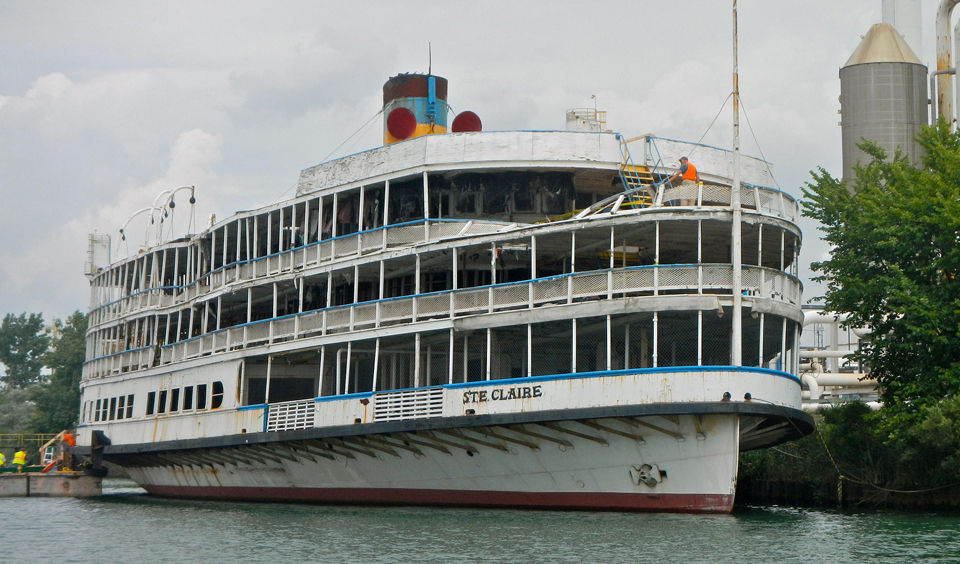
DETROIT—It is a bright, sunny Sunday afternoon. I am traveling along the shores of the Detroit River on the edges of our inner-city jewel, Belle Isle. As I turn onto the easternmost corner of the island, I see a haunting, hulking image. Majestic and stark, it looms in the near distance. I know immediately what it looks like, but I am amazed. Is that the Bob-Lo boat?
For those of us who grew up in the Detroit area, Bob-Lo is a sacred word. Anyone aged 35 or older knows of Bob-Lo Amusement Park and the two massive excursion boats that took passengers from the dock at the foot of downtown Detroit 18 miles downriver to Bob-Lo Island. Folks talk in idyllic, mystical tones about their childhood memories at the island. My great-grandmother, my grandmother, and my mother would take me on the bus ride from our home in Detroit to the dock. With an excitement equaling that of Christmas morning for me, we would board the boat.
I wore my white Bob-Lo sailor’s hat and always loved climbing the stairs down to the engine room to watch the machinery that pushed the steamship through the water. The smell was intense, a combination of burning oil from the engine and steaming water. When the boat docked, the kids would run down the ramp with arms waving wildly anticipating the first amusement ride of the day. Bob-Lo Island not only had the thrill-seeking rides of an amusement park, it also had the bucolic natural beauty for family picnics as well. I was able to take my son there a few times before the park closed in 1993, and even as an adult it was always the highlight of the summer.
Bob-Lo Island used two boats for the transportation of its passengers, the SS Ste. Claire and the SS Columbia. The last time I saw the SS Ste. Claire, at least a decade ago, it was docked way downriver and drenched in wind-torn shrink-wrap. Decrepit, it looked as if it was surely headed for the scrap yard. Its sister ship, the Columbia, had been sold to a New York investor and moved out of state. Ten years later, I have stumbled upon the Ste. Claire on this Sunday afternoon. I traveled off Belle Isle to get closer to this memory from my past. After crossing through a weed-grown vacant parking lot and climbing over a knocked-down fence I am able to stand face to face with this behemoth from my childhood. It is still alive. But there is a bleak side to this boat and its sibling, the SS Columbia, a story that has almost been lost to history.
On June 21, 1945, 24-year-old Sarah Elizabeth Ray had boarded the Bob-Lo boat. She had just graduated from secretarial school and, to celebrate, she and her classmates decided to take a ride to Bob-Lo Island. She had paid the 85-cent fare along with a dozen of her classmates and their teacher. The ticket taker made his rounds. These are Ray’s words of what happened next: “He took the ticket from my hand and then looked at my face. Two men in white coats came up to me and told me to leave the boat. They said Negroes were not allowed on the boat. My teacher said, ‘She’ll go quietly.’ That really added insult to injury. I got off the boat. They gave me back my money. I spent months with these girls and they turned their backs on me. I was so mad I threw the 85 cents at the boat.”
The only Black woman in the group, Ray was in violation of the ferry company’s rule against “Zoot-suiters, the rowdyish, the rough, the boisterous…and colored.” This rule against Black passengers was not unusual in America’s amusement parks. Throughout the first half of the 20th century this segregation in public accommodations was pandemic. To avoid being labeled strict segregationists the Bob-Lo Excursion Company initiated a “Colored Days” policy—allowing African Americans entry on low-revenue Mondays. Bob-Lo’s park police were specifically instructed to screen all prospective passengers to determine if any African Americans were attempting to sneak aboard.
These decisions to exclude were arbitrary and heartless. If you were light-skinned, you might be able to get to the park. In his autobiography, former Detroit mayor Coleman Young recalled being on an eighth-grade class trip in the early 1930s: “As we were loading the boat to take us to Bob-Lo, one of the guides jerked the cap off my head to check out my hair, and officially informed me that Black children were not permitted at the park…. I honestly wasn’t prepared for that. And I was never quite the same person again.”
Sarah Elizabeth Ray stood on the Woodward Avenue pier and watched as the Bob-Lo boat steamed out of port without her. Her next step would change history, years before the famous Brown vs. Board of Education Supreme Court case or Rosa Parks taking her infamous bus seat. In Ray’s words: “I was always a free soul. I was mad. I immediately found a pay phone and called the NAACP.”
The NAACP filed suit, arguing that the Bob-Lo Excursion Co.’s policy of barring Blacks from the boat violated Michigan law. The case first went to Recorder’s Court. The NAACP won the lawsuit. The court fined Bob-Lo a measly $25. Although the fine was nominal, Bob-Lo officials were worried about the signal that the lawsuit would send. They appealed to the Michigan Supreme Court, which upheld the findings of the lower court. But the Bob-Lo Excursion Company had no intention of accepting the court’s decision. It sought redress before the United States Supreme Court. Joining the NAACP in this legal battle were the National Lawyers Guild and the American Civil Liberties Union. The head of this legal team was none other the future associate justice of the Supreme Court and its first Black justice: Thurgood Marshall.
On February 2, 1948, the Supreme Court affirmed the rulings of the lower courts and found against Bob-Lo Excursion Company. The Court said the company “will be required in operating its ships as ‘public conveyances’ to accept as passengers persons of the Negro race.” Sarah Elizabeth Ray found her justice. Five years later Thurgood Marshall would go on to win the landmark Brown vs. Board of Education decision, banning “separate but equal” public schools.
How did Detroit let Ray become one of history’s forgotten women? March is Women’s History Month and I share this tale of a brave young woman to help us all celebrate the contributions of heroic women, wherever they may be. As I stare at the SS Ste. Claire, in its majestic disrepair on this March afternoon, I imagine a defiant, proud, angry Black woman throwing her 85 cents at this boat and swearing to herself that justice will be served. Ironically, after winning her legal battle, Sarah Elizabeth Ray never set foot on a Bob-Lo boat again for the rest of her life. You now know the story of “The Rosa Parks of the Bob-Lo Boat.”
Note: The SS Ste. Claire has been bought by a local doctor and he is attempting to refurbish it for use as an event and party facility. His first task was to reinforce the hull so that it remains floating. It is floating!












Comments